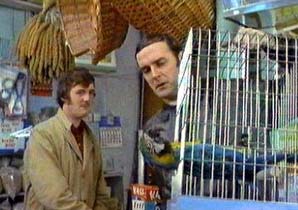
It has such a wonderful plumage.
Posted on 07/11/2005 12:57:33 PM PDT by aculeus
Waltham, Mass. -- A Brandeis University researcher has shown that an African grey parrot with a walnut-sized brain understands a numerical concept akin to zero -- an abstract notion that humans don't typically understand until age three or four, and that can significantly challenge learning-disabled children
A Brandeis University researcher has shown that an African grey parrot with a walnut-sized brain understands a numerical concept akin to zero -- an abstract notion that humans don't typically understand until age three or four, and that can significantly challenge learning-disabled children. (Image courtesy of Brandeis University)
Strikingly, Alex, the 28-year-old parrot who lives in a Brandeis lab run by comparative psychologist and cognitive scientist Dr. Irene Pepperberg, spontaneously and correctly used the label "none" during a testing session of his counting skills to describe an absence of a numerical quantity on a tray. This discovery prompted a series of trials in which Alex consistently demonstrated the ability to identify zero quantity by saying the label "none."
Dr. Pepperberg's research findings, published in the current issue of The Journal of Comparative Psychology, add to a growing body of scientific evidence that the avian brain, though physically and organizationally somewhat different from the mammalian cortex, is capable of higher cognitive processing than previously thought. Chimpanzees and possibly squirrel monkeys show some understanding of the concept of zero, but Alex is the first bird to demonstrate an understanding of the absence of a numerical set, Dr. Pepperberg noted.
"It is doubtful that Alex's achievement, or those of some other animals such as chimps, can be completely trained; rather, it seems likely that these skills are based on simpler cognitive abilities they need for survival, such as recognition of more versus less," explained Dr. Pepperberg.
Alex had previously used the label "none" to describe an absence of similarity or difference between two objects, but he had never been taught the concept of zero quantity. "Alex has a zero-like concept; it's not identical to ours but he repeatedly showed us that he understands an absence of quantity," said Dr. Pepperberg.
Historically, the use of "zero" to label a null set has not always been obvious even in human cultures, which in many cases lacked a formal term for zero as recently as the late Middle Ages. The value of number research lies mainly in its ability to help determine the extent of animal cognition and animals' potential for more complex capacities. To that end, Dr. Pepperberg's studies on the avian brain are continuing with research into Alex's ability to count, as well as add and subtract small quantities.
Yet significantly, Dr. Pepperberg's research, which uses a training method called the model-rival technique, also holds promise for teaching autistic and other learning-disabled children who have difficulty learning language, numerical concepts and even empathy.
The model rival technique involves two trainers, one to give instructions, and one to model correct and incorrect responses and to act as the student's rival for the trainer's attention; the model and trainer also exchange roles so that the student sees that the process is fully interactive. The student, in this case, a middle-aged parrot, tries to reproduce the correct behavior. So far, results using this learning technique with small groups of autistic children, taught by Diane Sherman, PhD, in Monterey, CA, have been very promising, said Dr. Pepperberg.
"This kind of research is changing the way we think about birds and intelligence, but it also helps us break down barriers to learning in humans -- and the importance of such strides cannot be underestimated," said Dr. Pepperberg.
Now - what will this finding do to the unearned self-esteem of precious retardee pupils?

It has such a wonderful plumage.
Can the bird be trained for work in a call support center?
The fruit flies disappear from my garden when there is "zero" fruit. Their "message" is clear enough. Am I missing something here?

My dog knocks over his dish when there's no food. Does that count??
In other words, Go Birds Go!
That's nothing: my late cat was always setting himself on a newspaper in the proper position to read the text - never sideways and never upside down. From which it is obvious that he was literate.
Why do I have this image of Sen. Kerry repeating the phrase "Pretty bird...Pretty bird".
I saw an African Grey in a shop over the weekend.
It must have a concept of zero.
When I asked it if Polly wanted a cracker, it said nothing.
I love African Greys (smart birds).
BTW, my conure says 'Uh oh!' when he see's the cats and "OUCH!" when he nibbles my ear.
Examples:
1) One macaw, Diva, shared a perch with two other macaws, she'd bite one, the other bird would bite back and she'd respond with one of the following 'Quit that!' 'Knock it off!' or 'Stop that!'
2) She'd go DA-DA-DA-DA-DA-DA-DA (the start of the 'charge' call) so damned loud I'd hear it over the vacuum cleaner. Repeat said call about 8 times and on the 9th call finish it off with a resounding CHARGE!
3) Another macaw we had, Pedro, we actually taught to lift one foot from his perch in a 'wave' motion while saying 'Hi'
This thread is good for another bump.
Disclaimer: Opinions posted on Free Republic are those of the individual posters and do not necessarily represent the opinion of Free Republic or its management. All materials posted herein are protected by copyright law and the exemption for fair use of copyrighted works.